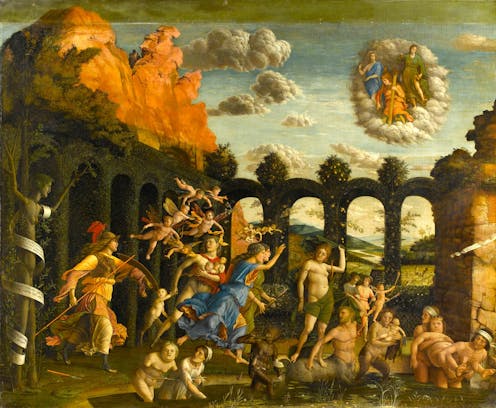how elite women played a crucial role in the Italian Wars of the 16th century
- Written by Susan Broomhall, Director, Gender and Women's History Research Centre, Australian Catholic University

Wartime has often presented opportunities for women to step into leadership roles denied them in peacetime. The Italian Wars, a series of military conflicts fought mainly in Italy between 1494 and 1559 by Europe’s dominant political powers, were no exception.
By the end of the wars, many parts of Italy had fallen under Hapsburg rule, joining an empire that stretched across much of the European continent and even to the Americas, shaping Europe’s power hierarchies for centuries to come.
Our new research has revealed the significant roles elite women played in prosecuting war and negotiating peace during this pivotal time in European history. We looked particularly at Isabella d’Este (1474–1539), marchioness of Mantua, and her sister-in-law, Lucrezia Borgia (1480–1519), duchess of neighbouring Ferrara.
Men deputised women to free themselves up to fight. They knew these women were well educated and would handle affairs competently. The women we examined made important administrative, diplomatic and financial contributions to retain power in small Italian states often perilously close to the front line.
Against all odds, both Mantua and Ferrara survived the wars, remaining in the control of the Gonzaga and Este families, respectively. This was in no small part because of the work of the prominent women within these ruling dynasties.
Lucrezia Borgia
Following her marriage in 1502 to Alfonso I d'Este, heir to the duchy of Ferrara, Lucrezia Borgia made important economic and political contributions to the war effort.
Ferrara was threatened first by its neighbour, the Republic of Venice, intent on expanding its land borders, and later by Pope Julius II, who wished to reclaim Ferrara as territory for the Papal States.
Lucrezia invested her dowry in land reclamation and food production. This was crucial to her husband’s capacity to pay for innovative new cannons, which proved lethal in a surprise attack in 1509, destroying the invading navy of the powerful Venetian republic.
In 1512, Alfonso was lured to Rome by the Pope to negotiate a peace settlement, only to find himself arrested and imprisoned. This left the duchess to oversee military preparations. With the Pope’s army occupying nearby towns, Lucrezia quickly organised the fortification of bastions on Ferrara’s borders.
She also outwitted the Pope’s spies by using an ingenious secret code. During Alfonso’s imprisonment, Lucrezia secretly updated him about the war. Unlike the usual system of encryption, Lucrezia’s worked by providing seemingly innocuous family news about their son, the state of her health and that of other family members. These were in fact strategic messages.
Alfonso finally escaped the Pope’s clutches with the help of Rome-based allies, and returned to Ferrara and the defence of the city-state he ruled.
Isabelle d'Este
Isabella d’Este, who became marchioness of Mantua when she married Francesco Gonzaga in 1490, was likewise a crucial actor.
She was 20 when Charles VIII of France invaded the Italian peninsula in 1494, and assumed increasingly weighty political responsibilities while her husband devoted himself to fighting.
Her authority was initially fragile. The citizens of Mantua were sceptical of the capacity of such a young woman. So Isabella commissioned works of art that associated her with virtues such as prudence, magnificence and fortitude.
This self-fashioning is on display in a medallion by Gian Cristoforo Romano. The obverse portrait evokes ancient Roman empresses and an illustrious dynastic pedigree. The reverse features Sagittarius flying above a winged female victory, an allusion to the marchioness’s fitness to exercise authority.
In 1512, the French military campaign to take territory in northern Italy collapsed. The victorious Spanish-led league – a coalition of powers including the papacy – convened a congress in Mantua to divide the spoils of war.
Pope Julius II – an ally of the Spanish Holy Roman Emperor, and determined to reclaim the duchy of Ferrara – demanded the imperial army oust Ferrara’s Este rulers as soon as the congress concluded.
As a woman, Isabella could not hold an official role at the congress. However, like Lucrezia Borgia, she worked diplomatically behind the scenes to save the Este regime of her brothers.
Isabella focused her diplomacy on the imperial general and Spanish viceroy of Naples, Ramón de Cardona. Personally guiding Cardona and his entourage around her prized collection of antiquities and paintings by leading contemporary artists, she convinced her foreign visitors to take her seriously as a woman of diplomatic consequence and eventually persuaded Cardona to delay the attack on Ferrara.
The reprieve Isabella achieved proved lasting. Julius II died in early 1513 and his successor, Pope Leo X, did not pursue the restoration of papal rule in Ferrara. The threat to Este rule had dissipated.
New visions of women and warfare
The Italian Wars provided women with opportunities to showcase their administrative competence and diplomatic talents, manipulate their own public image and associate themselves with attributes that would bolster their legitimacy in similar ways to male leaders.
Many placed emphasis on advancing themselves as women of influence, authority or power, showing (for better or worse) they, too, could be protagonists of war as well as peacemakers.
Looking through the lens of gender and at the activities of women permits a reconsideration of where and how early modern war was conducted. It shows the conflicts played out not just on the battlefield and during official diplomatic encounters, but also through cultural forms of politics and the dynastic service of female as well as male actors.
Authors: Susan Broomhall, Director, Gender and Women's History Research Centre, Australian Catholic University





